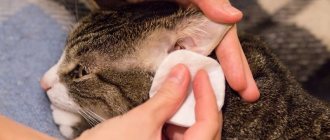Cerebellar ataxia in cats often develops as a result of congenital abnormalities of the nervous system. But sometimes the disease manifests itself as a complication of acquired pathologies. Characteristic symptoms of the disease are unsteadiness of gait, loss of coordination, and darting eyes. Treatment is carried out only after a comprehensive diagnosis and clarification of the factors that caused the disorders.
Causes
The most common cause of loss of coordination of movements is infectious diseases affecting the nervous system and brain. These, in most cases, include panleukopenia.
Cerebellar - often the cause of ataxia is aplasia of brain structures. This disease is congenital in nature and can arise both from a hereditary genetic predisposition and from developmental disorders in the prenatal period. Typically, sick kittens are born when the mother has panleukopenia. Also, the cause of damage to the cerebellum and the subsequent development of ataxia can be traumatic brain injury, inflammatory processes and cerebral edema.
With vestibular ataxia, there are two options for the development of the disease:
- The structure of the inner ear - the cause is its damage due to otitis media, neuritis of the craniofacial nerves, idiopathic vestibular syndrome and tumors.
- The medulla oblongata and brain stem are tumors.
Possible causes of disorders in spinal ataxia are intervertebral hernias, inflammatory diseases and spinal cord trauma.
Localization of damage in ataxia
Stroke in cats: symptoms and treatment, first signs
Depending on the location of the source of inflammation, the pathology is divided into the following groups:
- Cerebellar - appears with inflammation of the medulla oblongata and cerebellum. The disease can be either congenital or acquired.
- Vestibular - with inflammation of the inner ear system.
- Proprioretic - a form caused by damage to peripheral nerves.
- Spinal cord develops against the background of damage to the spinal cord.
In veterinary medicine, there are two forms of ataxia:
- static;
- dynamic.
In the first case, the kitten will not even be able to stand straight; in the second, on the contrary, coordination is impaired only during movement.
Pathology in kittens from birth
Symptoms
Despite the similar symptoms of all types of ataxia, there are different signs that depend on the cause of the disease.
All types of violations are characterized by:
- Staggering "drunk" gait. The cat walks with its hind legs widely spaced, raising them high.
- Changes in head position - usually it is tilted to the side or down.
When the spinal cord is damaged, pain occurs when walking, and the animal tries to move less. Very often there is no loss of coordination of the head.
Cerebellar ataxia is characterized by the presence of tremor during movement - when walking or running, the animal’s body trembles slightly, often only the back part. There may also be nystagmus, which is rapid eye movements that are independent of where the cat is looking or what the cat is observing.
If there is damage to the vestibular apparatus, then nystagmus is also observed, severe pain in the head is possible (the cat meows, sits in the corner with its forehead pressed to the wall).
Characteristic signs of collapse in cats
A characteristic sign of an animal falling over is twitching limbs.
When paralyzed, the cat lies in a straight position and attempts to move. If the cause is myopathy or myositis of the forelimbs, then the pet falls on its front legs.
The cat will lie in an upright position when paralyzed.
Diagnostics
One of the first diagnostic methods will be a thorough history taking. It is important to know about the cat's previous injuries, infectious diseases and nutrition. If possible, family heredity and the peculiarities of pregnancy in the mother cat are determined.
The animal is examined by a neurologist to assess the functionality and disorders of the nervous system.
Determine serological reactions to dangerous feline viruses - immunodeficiency virus, panleukopenia and leukemia.
If the clinic has the opportunity, then they conduct an MRI diagnosis of the brain; tumors, aplasia of areas, hemorrhages and edema are clearly visible on it. It is also possible to use ultrasound and radiography.
The ear is examined using an otoscope.
If there is a suspicion of infection of the brain or spinal cord, cerebrospinal fluid is taken to analyze leukocytes and protein, and a bacteriological examination is also carried out.
Help save the cat! The cat is dying.
Really need some good advice! After suffering from an illness, the cat was vaccinated some time later. After vaccination (on the 3rd day), the cat seemed to have lost his limbs (I can’t call him paralysis, because he still moves them). Side effects on the central nervous system. Stretching of the limbs as if in convulsions (the convulsions themselves are not observed, as the skier stretches out his paws and slides on the linoleum), twitching of the head while lapping up liquid, as if hiccups (but this is definitely not hiccups). The cat has been eating almost nothing for about 3 days (I feed him broth from a spoon), and goes to the toilet once every 1-2 days, “in a small way.” He doesn’t walk or sit on his own, he just lies on his side. He also has difficulty holding his head. The gaze is conscious, purrs. The doctor cannot do anything, the diagnosis is also unclear. Only the words: “I can’t say anything, all I can do is give injections and hope.” I have already stopped calling the doctor (the doctor is one of the best in the city, only good reviews). I don't want to put you to sleep. I believe that if there is even a small chance, it should be used. Help, what else can be done? Below is our entire medical history for professionals: I’ll start from the beginning: we adopted a small kitten (1-1.5 months) at an animal shelter (June 2012). The kitten turned out to be sick. A week later I lost a lot of weight, I was treated for an intestinal infection (the antiviral drug fosprenil, the immunostimulant catasal and the antibiotic I don’t remember the name of). He was cured within a week. October 2012 - the cat refused food. The reasons are unknown, we didn’t keep track, because... at that time the child was in the hospital. During the child’s injury, the cat really experienced stress, hid under the sofa and sat there for half a day. We contacted the veterinarian. The cause of the disease was never found out; a blood test was taken - everything was within the physiological norm. Treatment for about 3 weeks: fosprenil (antiviral), cobactan (antibiotic), catazal (immunostimulant). It seems that the cat has more or less come to his senses. We finished the treatment. A week later, the cat’s eyes “closed” (that is, the inner eyelid closed the eye by approximately 1/3). Back to the doctor. They said: feline herpes. We resumed fosprenil + anandin drops in the eyes and nose. We treated for 2 weeks. The cat did not feel better. Here at the clinic the head doctor (the owner of the clinic) took care of us. The cat has a temperature of 41.2 (normal 38-39). He prescribed an antibiotic (human suspension amoxiclav). Weekly blood monitoring (the blood, by the way, was normal). The cat is on the mend. The cat began to eat, play, in a word, returned to normal life. Treatment was completed on the 20th of December. After 10 days we were given an anthelmintic, and after another 10 days we were given the Multifel-4 vaccination. 2 days after vaccination, the cat seemed to be paralyzed. It felt like he was having a stroke. His legs were in convulsions, at first he walked on high, straight legs (like on stilts). I couldn’t keep my balance, I fell on my side, I could crash into a door frame, I refused to eat or use the toilet. Back to the doctor. Treatment: saline dropper + piracetam + vitamins B1, B6 alternately, + cerebrolysate (all drugs from a human pharmacy). On the 2nd day of treatment, hope was lost, but the treatment was not abandoned. On the 5th day the cat came to his senses. His joy knew no bounds. On the 7th day of illness, the cat again (out of nowhere, one might say) became ill. I pet him, give him a massage, stretch his paws, warm him up, give him injections and IVs. By the way, I have never had a more sincere and intelligent animal in my life. Can you imagine a cat playing hide and seek with a child! Despite all his illnesses, there was never any thought of abandoning him. You never expect a trick from him, he will never do dirty tricks or steal something from the sly. Every morning I wake up and every day I return from work and there is no confidence that he will wait for me...
Treatment
The tactics of the prescribed treatment depend on the causes of ataxia. B vitamins, especially B12, are mandatory. Gamavit is used to strengthen the immune system and the body as a whole.
The medicinal substance Proserin also penetrates well through the blood-brain barrier and helps restore nerve conduction.
With cerebellar ataxia, treatment of the disease is extremely difficult. After all, the basis of the disease is degenerative changes in the brain. Cerebrolysin (Cerebrolysate) is used to improve cerebral circulation and tissue regeneration.
To improve the functioning of brain tissue, glycine is used 0.25 t once a day for 2 weeks, piracetam 0.3 ml IV and caviton 0.25 t 3 times a day for a week.
In case of spinal cord damage, surgical treatment is prescribed in most cases. Physiotherapy is also used - UHF, UMI (pulse therapy), massage.
If there is an infection, then antibiotics are used - ampicillin, vancomycin. Often the cat will require anti-toxic therapy. To do this, use a drip infusion of saline solutions - saline solution with glucose. Glucocorticosteroids – prednisolone – are also administered.
If there is cerebral edema or hydrocephalus, diuretics are prescribed - furosemide, veroshpiron.
Severe tremor can be relieved by using diazepam, but in this case it is necessary to carefully monitor the condition of the liver and prescribe minimal doses of the drug, as it is toxic to the liver.
Owners of kittens with cerebellar ataxia should remember that after the animal reaches the age of 1 year, its condition stabilizes, and the pet can continue to live happily. Such pets have extraordinary intelligence and kindness, but they require the safest possible life and good care, and, of course, love and affection.
Now in the United States there is even a special queue where residents sign up to shelter animals with this diagnosis.
The cat cannot walk on his own and falls over on his side.
Hello, we have this problem. The cat cannot walk normally for 3-4 days; it “slides” to the left. Initially, he was limping on his left leg, it gave way inward, and now the entire left side seems to be giving out. They started visiting the doctor after Senya became lethargic and inactive. We were told that the problem was in the kidneys, we were given IVs, but the condition did not improve. Then they did an ultrasound, there was nothing wrong. To check, the doctor decided to take a picture of the lungs, it turned out that there was swelling there. Just now we stood in line for an ultrasound of the heart; it turned out that this is very problematic in Moscow. During treatment, vitamins were injected, the condition improved, the cat ate, and seemed cheerful. Then he just started limping on his left leg, we thought that the injection into the muscle was unsuccessful, since we give injections ourselves. But the doctors said it goes away quickly. For a while he began to walk normally, as usual. And then, as I said, I began to collapse. Today everything has completely worsened, he cannot walk independently, only if he is supported on the left side. Refuses to eat. He seems to be able to feel his hind legs, they even checked them with a needle. Sena is 13 years old. Please help, we are very worried about our cat!
Prevention
- Mandatory vaccination against panleukopenia, rhinovirus and feline leukemia virus.
- To avoid injury to the animal as much as possible, it is advisable to limit free access to the street.
- Careful protection of the health of a pregnant cat, a ban on its communication with other animals.
- When planning a mating, be sure to check the cat for panleukopenia.
- Timely treatment of otitis and inflammatory ear diseases.
- Urgent hospitalization of a cat if a traumatic brain injury is suspected.
- Check with the breeder about genetic diseases in relatives and about the mother’s pregnancy history.
How to play with a kitten
To develop coordination of movements, it is useful to arrange games with “prey” in the form of a toy mouse or other object suspended on a fishing rod with a string. It needs to be moved along the floor or slightly raised above the surface. There is no need to force your pet to reach for a toy; such a kitten does not stand well on its hind legs. Also, do not force your pet to jump, otherwise it may end in a fall.
But throwing movements work well for kittens with ataxia. The animal may ambush the toy. In this case, the kitten usually turns over on its back and grabs the prey with its paws. Developing such movements in a cat is very useful.
We must not forget about games for the development of fine motor skills. Nowadays, there are special puzzles for cats on sale with balls and toys hidden inside, as well as mazes. Such toys are very useful for animals with ataxia, as they help develop the accuracy of small movements.
All educational games must be supervised by the owner. After all, cats with ataxia fall very often.
How to make your home safe for your pet
Since there is no effective treatment for cerebellar ataxia, it is very important to protect your pet as much as possible from injury from falls. After all, a lack of coordination will accompany the animal throughout its life. To prevent the kitten from getting hurt, you must follow the following rules:
- It is very important that the floor is not slippery, otherwise the animal’s paws will move apart greatly. Wood flooring should be smooth to prevent your pet from getting a splinter. The ideal surface is carpet. It will be convenient for the cat to move around. You can also cover the floor with rugs.
- It is necessary to remove from the floor all large unnecessary objects that the cat might stumble upon while moving.
- Many cats love to climb on bedspreads and curtains. Such vertical surfaces must be securely fastened. You need to pay attention to the length of your pet’s claws. After all, with their help the animal clings to the fabric. You cannot cut the nails too short, otherwise the pet will not be able to hold on to them. At the same time, the claws should not be allowed to curl and get stuck in the fabric.
- Feeding cats with ataxia should be supervised by the owner. An animal with a movement disorder often splashes water and scatters food. Therefore, bowls should be placed so that the feeding area is easy to clean. After eating, you need to wipe the animal's paws and face.
It is important to remember that with ataxia, independent walks are strictly contraindicated for cats. Such animals can get hit by a car; they cannot defend themselves from aggressive relatives and cannot escape from dogs. However, pets with ataxia usually enjoy movement. They can be walked, but only on a harness.











